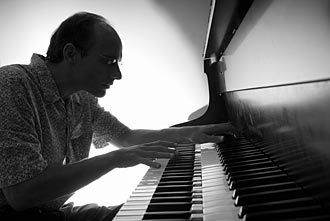Playing double: A UW pianist gets hands-on with a unique instrument
Christopher Taylor has two pianos in his campus studio. One has eighty-eight keys; the other has almost twice that many.

Christopher Taylor shows off the capabilities of a double-keyboard Steinway in his UW–Madison studio. An internationally renowned pianist, Taylor is the unofficial keeper of the one-of-a-kind instrument.
Photo: Jeff Miller
Taylor, an assistant professor of music, is the unofficial keeper of a double-keyboard Steinway. Featuring eighty-eight keys on the bottom and seventy-six on top, it’s the only such instrument the piano maker ever manufactured. Made in Steinway’s factory in Hamburg, Germany, in 1929, and based on the design of Hungarian composer Emanuel Moor, the piano arrived at the School of Music in 1961, when artist in residence Gunnar Johansen convinced officials to buy it.
Taylor first found out about the piano in 2004, after the death of Johansen’s widow. “I had never been aware of its existence, and the fact that the university owns it was a complete surprise,” he says. “Of course, I was burning up with curiosity. At that point I had no idea how it worked — if it had strings or double strings, what was going on.”
A peek under the lid shows the instrument has one set of hammers and strings. When Taylor plays a note on the upper keyboard, the same key is pulled down on the lower keyboard.
“I didn’t expect that, but it became easy enough to ignore,” he says. “In a way, it’s kind of comforting.”
The piano also has four pedals, compared with the two or three found on a standard model. The fourth is the octave pedal, which “doubles” each note Taylor plays on the lower keyboard, playing it one octave higher on the upper keyboard.
When Taylor first played the instrument, it clearly needed some work done, which he mentioned during his first performance on the double keyboard during a 2005 concert at Mills Hall. Chancellor John D. Wiley MS’65, PhD’68, who is a fan of Taylor’s and was in the audience, helped to secure private funding to send the piano to the Steinway factory in Queens, New York, where it was refurbished in fall 2006. Taylor says that while School of Music technician Baoli Liu had some ideas about how to do the necessary repairs, Steinway had to improvise solutions, since drawings or other historical documents for reference no longer exist.
“At first, I think they were kind of thunderstruck by this thing and weren’t entirely sure what to do with it,” Taylor says. “It’s not in any of the piano technician training manuals.” Instead of shipping the entire piano to Steinway, the School of Music slid out the keys and hammers, a single unit called the “action stack.” A Steinway technician dissected the action stack, taking pictures as he went along, then created and installed custom-made springs and pins to replace those that were broken. By the time that work was complete and the keyboards were reunited with the piano, the difference was noticeable. For example, Taylor says, keys are lighter to the touch and feel more consistent.
For a gifted musician such as Taylor, the instrument opens up possibilities that aren’t feasible on a single keyboard, including the ability to cover two-octave intervals with one hand. Yet he had only a single thought when he first heard about the piano: “I’ve got to try the Goldbergs.”
He had previously played J.S. Bach’s Goldberg Variations, originally written for manual double harpsichord, on a standard piano. But the “voices” cross one another quite a bit, resulting in a lot of acrobatics to avoid tangling up the pianist’s hands.
Taylor “learned to negotiate the collisions,” he says, when he first played the Goldberg Variations several years ago. Watching him perform a section of the variations on just a single keyboard reveals the challenges: the body contorts a bit, one hand reaches around the other to hit certain notes, and, at some points, one hand practically has to play underneath the other. It makes it easy to understand why Taylor looked forward to trying the pieces on the unique piano, and why he hopes to do a recording.
He made a splash in classical music circles during the summer and fall when he used the double Steinway to perform the Goldberg Variations at the Ravinia Festival, outside of Chicago, and the Caramoor International Music Festival in Katonah, New York. Audience response was enthusiastic.
“Sometimes people expect to hear something totally unexpected and new,” Taylor says. “For people who are on audience right, they don’t necessarily perceive that much difference. Now, for people who are on audience left, on the other hand, they get an interesting show.”
Tags: arts, School of Music



